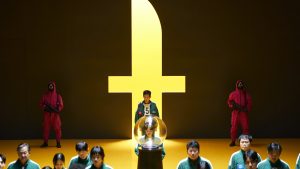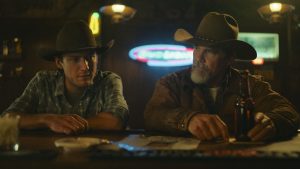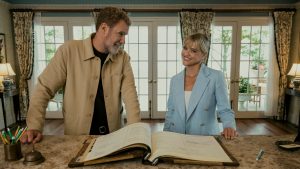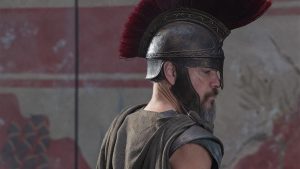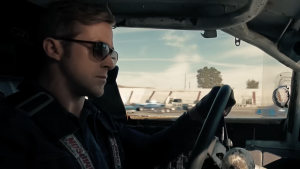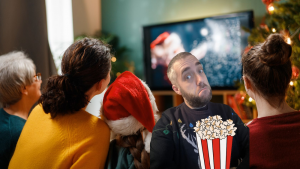
This article contains Death of a Unicorn spoilers.
“You know what? We really must put more stock in art history.” This is a moral truth that should be repeated. It also, perhaps, is a thought that flashed through the mind of Odell Leopold (Richard E. Grant) right before a unicorn’s horn also smashed into that soft, squishy gray matter. It might have similarly been in the back recesses of Belinda Leopold’s (Téa Leoni) head while another unicorn opened her belly.
They were both warned earlier in their movie by art history student Ridley Kintner (Jenna Ortega) that ancient masterworks tell us of the dangers posed by horned mythical creatures. She even had JPEGs of the fancy medieval tapestries to prove it, with scenes of death by unicorn disembowelment and all. But they refused to listen.
It’s a comical sight befitting a movie purposely infused with Jurassic Park imagery as rich elites attempt and fail to control the natural world. Yet it’s not only a gag. In fact, Death of a Unicorn writer-director Alex Scharfman extensively studied unicorn mythology and folklore, telling us previously in a Den of Geek cover story that he went back to Roman historians and the Old Testament Bible while researching the film. He also intensely examined those unicorn tapestries you see in the movie. Aye, they’re real and currently reside in the Met Cloisters in New York City. So we recently decided to sit down again with Scharfman to discuss how deeply these Hunt of the Unicorn tapestries informed his film.
“I grew up around New York in the suburbs and went on field trips to the Cloisters Museum where those are held and maintained,” Scharfman recalls in our latest interview about the film and these Gothic wonders. “They must have been buried in my unconscious, because at some point I forgot about them but then when researching the movie, I came upon them again and I was like ‘oh right, those things!’”
These tapestries, which were made by an unknown artist at the turn of the 16th century, and then resided in an aristocratic Parisian home until nearly being destroyed in the French Revolution, became a North Star for everything in Death of a Unicorn. Ortega even previously told us they were a “cheat sheet” for understanding their movie. So join us below as we unpack each of the seven tableaus composing the Unicorn Tapestries while Scharfman explains how they influenced and shaped his man-eating unicorn creature feature.
A24 / Met Cloisters
The Hunters Enter the Woods
An interesting thing to note is that while the Cloisters and many art historians place these tapestries in a generally recognized sequence—and it is the sequence we are using in this article—no one is exactly certain about the official order of things.
“There’s not like on the back of them a ‘number one’ or a ‘number two,’” Scharfman explains, “so people have put them in an order that seems to make sense. And I totally agree that this makes sense as the first one, but one thing that I thought was fun with the movie is they’re not necessarily in the right order.”
Still most agree this is the first composition since it distinctly lacks either a unicorn or a king and/or lord. Instead it is just dogs and kingsmen approaching a formidable wilderness.
“One thing that’s nice about this tapestry specifically is there’s just so much foliage and just this overwhelming sense of nature,” says Scharfman. “That is something people write about with the Unicorn Tapestries a lot: this sense of the way nature is depicted.” Yet it is the humans in this specific tapestry that inspire so much of the bent of Death of a Unicorn, the movie about a CEO, or feudal lord, who summons a prospective servant, Paul Rudd’s Elliot Kintner, to court.
“I think it’s telling that [the Lord] is not in this one,” Scharfman says. “He sent out his minions to go get him this thing that he wants in the woods and to bring it back for him. So I totally think when you start digging into the tapestries, and more broadly most medieval unicorn mythology and lore, you end up with something that really presents itself as a class commentary in that way.”
The writer-director notes that he also modeled one of his shots of Grant leading Rudd and other characters into the wilderness while hunting a unicorn specifically after this tapestry.
A24 / Met Cloisters
The Unicorn Purifies Water
The next tableau sets the scene of a unicorn purifying the water in an enchanted fountain hidden deep within the wood. The implication is that the unicorn’s horn, and perhaps blood, has restorative magical powers, which some scholars perceive as an allusion to Christ. The myth about a unicorn’s body having healing properties long predates the tapestries and was already a key element in Scharfman’s vision for the developing movie when he rediscovered these tapestries. But this image had other significant influences on the film.
“It’s a funny thing,” Scharfman chuckles, “I don’t know why there’s this fountain in the woods. The unicorn is not purifying a stream, it’s purifying water from a fountain that’s pouring out.” It is an odd sight, but one the director sought to recreate by placing a near replica of this fountain in the Leopold estate: “In the courtyard of the house, there’s a fountain that is exactly like that one. We modeled it pretty much as close as we could possibly get to it… and that is where the unicorn is discovered by most of the characters.”
Furthermore, this tapestry inspired even the name of the film’s villains.
Says Scharfman, “Among the other animals that are drinking from the water in this tapestry, there are a couple lions, and the Leopold family is of course the antagonists, the pharmaceutical family in the movie.” As the director acknowledges, the name “Leopold” is an allusion to Leo the lion in astrology. The Leopolds’ company sigil is also a lion.
“In a lot of unicorn mythology, lions and unicorns were enemies,” Scharfman adds. “But here they’re kind of allies, or at least the unicorn seems to be happy to let them drink from the water the unicorn has purified.” It’s a departure from the myths, as well as where Death of a Unicorn goes next….
A24 / Met Cloisters
The Unicorn Crosses a Stream
In this scene, the kingsmen fall upon the poor unicorn and begin their attack as it attempts to flee across a stream. The image sets the stage for the bigger carnage to come later, but right down to the costumes of the hunters, beginning with the gent attending to the dog in the bottom left corner, this image helped inform the look of many of costume designer Andrea Flesch’s creations for the film.
“There’s certainly lots of little textures and details like Will Poulter’s bathing suits,” Scharfman comments. “There’s these really great stripes, vertical stripes on one of the characters’ pants, and that was certainly an influence that we took for Will. Costume-wise, Paul wears blue throughout the movie, Jenna wears red throughout the movie. They’re kind of moving towards each other [which gives you purple]… the Leopold family, which is played by Richard, Téa, and Will, they wear a lot of gold. Gold, white, black, that’s their palette, and when you look at the characters in these tapestries, they’re wearing red, blue, gold, and then there’s a lot of green in the background.”
Even the scientists’ lab coats in the film are made to mimic the high collars of late Middle Ages fashion.
A24 / Met Cloisters
The Unicorn Defends Himself
Now we get into the images that really start to influence the strange, bemused tone of Death of a Unicorn. And we are not referring to the orange tree high above the action of this scene or the red-roofed castle far off in the background. Both of those informed the look and garden of the Leopold estate, which the director is quick to point out to us. But it is the violent carnage and death in the foreground of this tapestry that immediately catches the eye.
“This was one of the first bits of unicorn violence that I had seen in any artwork,” Scharfman remembers. “When you look in this tapestry, when you go up close and you see it, it’s stabbing this dog in the intestines. It’s a hunting dog, so I think it’s self-defense. But when you go very close or if you got a high enough resolution version of it, it is very gory with the level of detail in this wound that it’s inflicting on the dog.”
He continues, “Beyond that it’s also kicking with its hind legs, which when you go back into historical accounts of unicorns, there is a lot of violence described and there’s a lot of very violent imagery that you can find. They were not these passive creatures. They really were not afraid to bite and kick and use their horn to gore people.”
Scharfman admits that ripping out a character’s intestines like he depicted happening to poor Belinda was his own flourish, but “there are accounts of them using their teeth to bite people, so it felt like it wasn’t that big of a jump.”
A24 / Met Cloisters
The Unicorn Surrenders to a Maiden
Perhaps the most influential tapestry on all of Death of a Unicorn, “The Unicorn Surrenders to a Maiden” is as important for what it doesn’t show as for what it does.
“Jenna wears a red hoodie throughout the movie, which has a very unusual shape,” notes Scharfman. “This actually is very much inspired by what the maiden is wearing in this, with these very kind of wide sleeves. And that was a hoodie we found from a Japanese designer that they made in gray and other colors, but we asked them to make it custom for us in red. It had this really interesting cloak kind of shape to it.”
After discovering this tapestry, it became quite indicative of how Scharfman imagined the Ridley character within the film: “It got me thinking, ‘Well, what is a pure hearted maiden in 2025?’ And I started thinking it’s probably a Gen-Z leftist who’s protesting on a campus somewhere right now. Someone with very strong morals and ideals.”
However, more than just the idea of having a pure-hearted maiden, this tapestry’s incompleteness created space for Scharfman to fill in his own grisly details.
“When you look at it in real life, it’s about a third the size of the other ones,” the director points out. “That’s because it was tremendously damaged. It was recovered after the French Revolution, so it is believed to have been damaged during the revolution, perhaps. It was used on top of a sack of potatoes to keep them warm in the winter time, and so they got totally tattered.”
What is left of the tapestry is actually torn into two pieces, and it is missing crucial information… like the maiden it is named after.
“If you look in the bottom right corner of this tapestry, just under the unicorn, you can see a woman’s hand,” says Scharfman. “So the maiden that the unicorn is actually surrendering to is not in the tapestry, which is very confusing. This is another maiden who happens to be like a handmaiden working with the maiden who is the bait. And I thought about putting that into the movie, but I was like ‘that is so confusing to try and teach people’—that there is a maiden in the tapestry, but that’s not the maiden it’s surrendering to. It’s surrendering to an off-screen maiden that we’ll never see.”
Nonetheless, the actual maiden’s absence gave Scharfman the creative liberty to suggest there is a fuller, more complete “lost tapestry” introduced in the film that includes so much of the monster movie mayhem that was to come.
“We had these brilliant artists do this incredible artwork to take the figures of the tapestries and the style of the tapestries, and infuse it with scenes from our movie,” he explains. “So we expanded this tapestry into this lost tapestry that includes a lot of the kills and a lot of the fun elements of the horror language that we employ in the movie, but to put it in this medieval context.”
It also allowed Scharfman to reconfigure the way the tapestries are meant to be interpreted. Whereas the following two tapestries are perceived by many historians to be the end of the story, in Scharfman’s film the actual ending is this tapestry with the maiden and unicorn resting after all the death and carnage had been carried out.
A24 / Met Cloisters
The Hunters Return to the Castle / The Unicorn Rests in a Garden
The last two actual tapestries tell an interesting if aloof conclusion to their tale: first the unicorn appears to be deceased, presumably killed by the hunters after the maiden beguiled the mythical creature long enough for them to get close—and then the creature appears to be resurrected and curiously happy in captivity.
Of the former tableau’s influences, the Lady of the Manor’s golden gown informed Leoni’s cream colored suits in the movie. Scharfman also points to the shape of the unicorn’s corpse as it lies draped over a horse in the center of the scene. “When the unicorn is killed [and taken to] the house in our movie, it has a similar pose where it’s kind of draped out the window of a car,” says the director. In which case, perhaps historians’ interpretations of the tapestries’ sequence is wrong, and this is the real first tapestry, which like Death of a Unicorn sets the stage for all the carnage that is to follow?
Either way, it’s the generally accepted final image of the story which inspires at least the oblique motivation of the film’s greediest Leopold, Will Poulter’s nepobaby Shepherd. “The unicorn in captivity, that is the vision that Will Poulter’s character is going after,” Scharfman says. “This idea that we can own this thing and possess it forever, and it will be ours within these confines.” Yet there are multiple ways of reading the actual tapestry.
Adds the director, “What’s funny about it is when you look at it, it has a very thin chain on it. It seems like it could break out of this, but it’s not. So there are questions about the symbolic meaning there. Is it there by choice? Is it there being held as captive? Who knows? But that is his vision of the future if [Shep] can possess them and contain them. Then he will have a limitless supply of unicorns.”
Given the tone and tenor of Death of a Unicorn, we might suggest the creature’s contentment is nothing more than medieval propaganda for how they actually handle confinement. Whatever the case might be, the film ends with the beasts running free and even attacking the police vehicle that Elliot and Ridley are being driven away in. However, Scharfman doesn’t think his film’s heroes are in too much danger.
“I think they’re there to try and help Jenna and Paul’s characters,” Scharfman muses of his unicorns, “but I also think they don’t really understand how cars work or police, or how any of these things actually function, because they exist outside of society.” Still, should either Ridley or Elliot perish in the ensuing car crash, it’s no biggie. “Worst case scenario, they can resurrect some people.”
Much like the tapestries show, when it comes to unicorns, death is more of a temporary inconvenience than a bitter fact of life. And with any luck, Death of a Unicorn might inspire some folks to learn more about the O.G. medieval roots of the pop culture creature.
“We put a lot of easter eggs from these tapestries into the movie, and I think there’s something fun about that,” muses the filmmaker. “Hopefully it adds a layer of rewatchability and maybe sends some people to the Cloisters to check out the tapestries in person.” That would be a nice kind of enchantment.
Death of a Unicorn is playing in theaters now.
The post Death of a Unicorn: The Real Medieval Lore and Tapestries Explained by the Director appeared first on Den of Geek.
